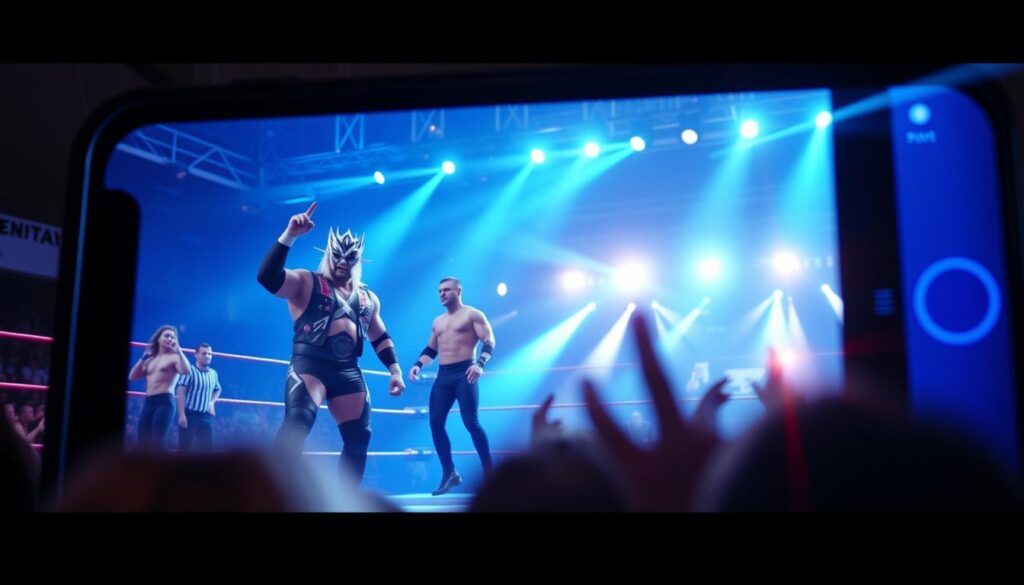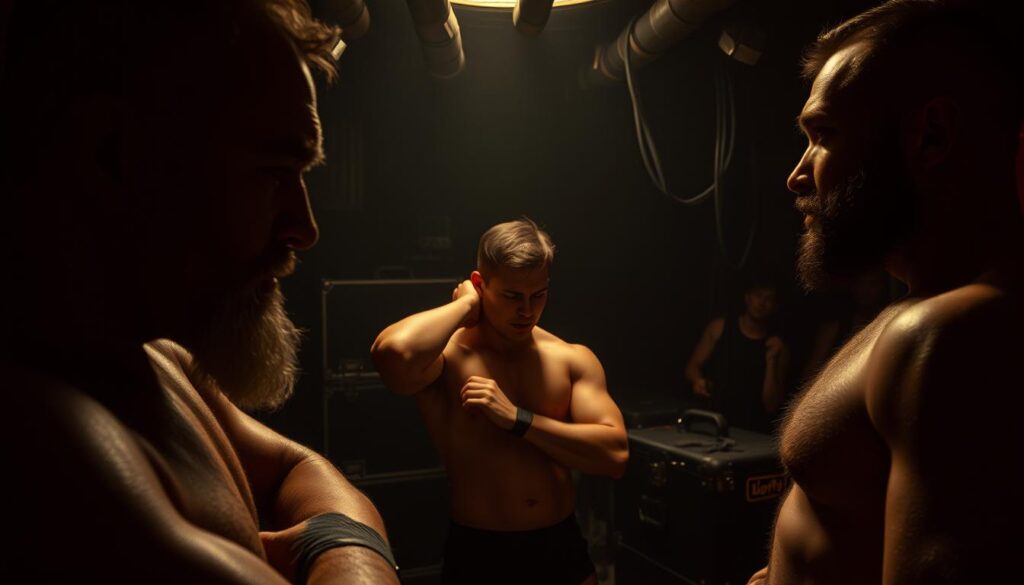Imagine two wrestlers getting pulled over in 1987 with drugs and a tire iron. The cops found Hulk Hogan’s worst nightmare – Iron Sheik and Jim Duggan in the car. This simple arrest shook the wrestling world because it broke kayfabe.
Kayfabe is like the fourth wall of wrestling. It makes body slams seem like Shakespearean drama. Razor Ramon is seen as a Cuban gangster, and Macho Man’s anger is real. It’s like reality TV, but with more wrestling and less ads.
The Sheik-Duggan scandal was like catching the Kardashians not filming their “casual” brunch fights. But kayfabe isn’t dead. It’s just found new ways to thrive, like on TikTok.
Politics and influencer culture also use this art of collaborative fiction. When a senator tweets angrily or a YouTuber drops their AirPods, they’re not breaking character. They’re living their gimmick.
From Sgt. Slaughter’s military look to today’s Instagram activists, we’re all part of someone’s story. The big question is: Which parts of your reality are scripted? And who’s writing the script?
History of Kayfabe
Imagine sweaty carnies selling “real fights” to people in the 1930s. Their pockets were empty, but their imaginations were full. This started the world of kayfabe, a term meaning “keep the business” in pro wrestling. It began as a trick but turned into a deep theatrical code.
This code changed wrestler merchandise history and American pop culture.
From Carnivals to Cable TV
In 1934, a “shooting match” at Chicago’s Wrigley Field showed kayfabe’s power. Fans paid to see a real fight between Jim Londos and Jim Browning, but it was staged. This made promoters realize people wanted to be fooled.
Places like Verne Gagne’s AWA made this deception into an art form. Wrestlers lived their characters all the time. Hulk Hogan’s bandana was more than just a hat; it was a symbol of his “Real American” image.
Vince McMahon’s 1989 Senate testimony was a turning point. He said wrestling was “entertainment, not sport.” This should have ended kayfabe. But instead, it made wrestling even bigger.
Cable TV wanted more over-the-top characters. Ric Flair’s $500 sunglasses became a must-have item. Merchandise tables became places where fans could buy into the illusion.
Let’s look at two key moments in history of wrestling styles:
- 1984: World Class Championship Wrestling used real-life tragedies as storylines, making fans cry for the characters
- 2021: AEW’s CM Punk did a “worked shoot” promo, making fans question reality
Today, wrestling is all about playing with the line between reality and show. It’s like a Vegas magician who winks during a trick. Modern wrestling asks, “Why end the illusion when you can sell tickets to the reveal itself?”
When and Why Wrestlers “Keep the Secret”
Imagine finding out your favorite superhero actor can’t fly but charges $20 for autographs. This is like kayfabe economics. The wrestling world’s secret isn’t just to keep magic alive. It’s also to keep the money flowing.
Backstage Politics and Paychecks
In the 1980s, kayfabe was more than just acting—it was about making money. Wrestlers like Kamala made extra cash by sticking to their character during meet-and-greets. The idea was simple: mystique = merchandise sales. Fans were happy to spend $30 on foam fingers, thinking they were supporting their “real” heroes.
Mick Foley’s 1999 book Have a Nice Day changed everything. It was like showing the strings behind the puppets. Wrestlers had to decide: cash in on reality TV or keep the magic alive? Dwayne Johnson found a middle ground. His “Rock” character was a wink to the audience while selling out arenas.
| Era | Financial Incentive | Fan Interaction | Key Example |
|---|---|---|---|
| 1980s | Character-driven merch sales | Strict kayfabe at events | Andre the Giant’s unchallenged mythology |
| 2000s | Reveal-all book deals | “Smart” fan Q&A sessions | Mick Foley’s autobiography sales |
| 2020s | Social media engagement | Meta-commentary in promos | The Rock’s TikTok persona |
Today, wrestlers walk a thin line. Tweeting too much can hurt storylines. Keeping quiet might mean missing out on going viral. John Cena’s “Never Give Up” phrase works for both gym posters and scripted matches. The secret is alive, but it’s made money in new ways.
The Evolution and “Death” of Kayfabe
Imagine Shakespeare’s Globe Theatre selling backstage passes during a show. That’s what happened to wrestling’s secret in the late ’90s. It was a big change that made kayfabe less strict.
Bullet Through the Curtain: 1997’s Infamous Betrayal
The Montreal Screwjob was a big moment in wrestling. It showed Vince McMahon as a both villain and visionary. Bret Hart’s scripted loss became real, making fans wonder what was real.
This event and the Kliq’s “Curtain Call” changed wrestling. Fans started to see it as a meta-narrative. They analyzed it like film critics.
Reality TV’s Scripted Revolution
Total Divas made backstage stories popular. Wrestlers acted like themselves, mixing reality and fiction. This was a new chapter for kayfabe.
- Dark Side of the Ring documentaries peeled back the curtain while increasing mainstream interest
- WWE’s YouTube series became kayfabe’s new playground, mixing scripted promos with genuine locker room footage
- Fans began treating wrestling like Marvel movies—analyzing Easter eggs in promos and post-show social media teases
Today, fans want more than just fake or real. They want layered realities. When Becky Lynch tweets before a scripted loss, it’s not a break. It’s evolving kayfabe into something new.
Kayfabe in Social Media Age
Imagine a world where wrestlers argue about championship belts on TikTok. They even have scripted rivalries on Instagram Story polls. Welcome to pro wrestling’s digital frontier, where reality vs story is all mixed up. Social media didn’t kill kayfabe; it made it endless.
Twitter Fingers and Worked Shoots
WWE’s TikTok strategy is like a Marvel post-credits scene. Bianca Belair shares hair-care tips that also show her character. Logan Paul drinks Prime Hydration during matches, blending product placement with his persona.
Remember when the I Love Bees ARG revealed wrestling’s secret? Today, fans analyze backstage drama on Twitter like it’s a mystery. When indie wrestler Beau talked about a schoolyard fight, it sparked lots of theories. It shows that today’s “worked shoots” are all about digital mystery.
Why does this work? Because today, people love reality vs story mix-ups. Wrestlers are like augmented reality filters — athletes and content creators all in one. The big question: Is your Instagram bio “3-time champion” just kayfabe, or good personal branding?
Philosophical Debates
Forget Shakespeare—modern drama unfolds in spandex as wrestlers navigate truth’s elastic boundaries. The philosophical art of wrestling doesn’t just entertain; it holds up a funhouse mirror to our collective hunger for ritualized conflict. What if every piledriver contained multitudes?
Is Wrestling Performance Art?
Kabuki theater’s crimson-faced warriors and wrestling’s chrome-domed villains share DNA: both trade in exaggerated archetypes that reveal uncomfortable truths. Roland Barthes nailed it in his 1957 essay “The World of Wrestling”, arguing grappling spectacles distill morality plays into “the perfect intelligibility of reality.” Yet UFC’s “as real as it gets” branding feels quaint compared to wrestling’s postmodern ballet of kayfabe’s modern evolution.
Consider neurodivergent thinker Beau’s mask metaphor: code-switching becomes survival theater. Wrestlers aren’t lying—they’re layering truths like Russian nesting dolls. When The Rock raises an eyebrow, it’s Kabuki-grade semiotics meets Jersey Shore charisma.
| Performance Type | Reality Acknowledgment | Audience Role | Emotional Core |
|---|---|---|---|
| Pro Wrestling | Suspended disbelief | Active conspirators | Cathartic justice |
| Kabuki Theater | Stylized tradition | Cultural custodians | Mythic resonance |
| UFC | Documentary realism | Bloodsport tourists | Raw aggression |
| Reality TV | Manufactured authenticity | Voyeurs | Schadenfreude |
Wrestling’s genius lies in its participatory fiction—a term that sounds oxymoronic until you’ve seen 80,000 fans willingly trade reality for revelation. It’s not about fooling people, but creating a shared language where steel chair shots become sonnets and tag-team betrayals echo Greek tragedies. The real question isn’t “Is it fake?” but “Why does this fake thing feel truer than my group texts?”
Stories from Wrestlers Old and New
Wrestling’s backstage stories are like a time capsule. They mix Shakespearean drama with late-night diner gossip. The old-timers share tales of cigarette smoke and spilled beer. The new stars, on the other hand, are all about TikTok-ready humor. Let’s open up the bag of secrets.
Locker Room Confessions
Pat Patterson once sneaked a rubber snake past customs to keep Jake Roberts’ character alive. He whispered “This damn thing better not get me arrested” as TSA agents looked at his bag. Now, Orange Cassidy texts during matches, showing how wrestling is all about being absurd.
Here are four stories that mix truth and fiction:
- The Tragic: Jake “The Snake” Roberts got so upset at airport security, they almost pulled out tasers. It was like his character was taking over his life.
- The Absurd: Vince Russo wrote WCW scripts where wrestlers pretended to be real. It was like a crazy game of make-believe.
- The Ironic: AEW wrestlers do “unauthorized” interviews that always go viral on Twitter. It’s like they’re playing a game of social media.
- The Nostalgic: FTR started a $200 vintage merch line. It’s like they’re bringing back the Road Warriors with overpriced t-shirts.
Today’s wrestlers see kayfabe as a story they can change anytime. When Jungle Boy posts gym selfies saying “Getting ready to job on Dynamite”, is he playing a role or starting a new one? The rules of the locker room fit in a phone, blending theater and internet fame.
Cultural Impact on Fan Community
Wrestling fandom has grown from backyard chairs to global politics. It started with local fans but now connects cultures worldwide. Global influence of wrestling fandom is about more than just wrestling. It’s about shaping identities together.
From Marks to Smarks
Today’s fans don’t just watch; they interpret symbols. Think of Lucha Libre masks at feminist protests, turning a wrestling trope into a political statement. Or Japanese fans cheering for Kenny Omega, mixing Shinto with Toronto humor. These fans are more than fans; they’re cultural transformers.
Reddit’s SquaredCircle forum is like a digital lab. It’s where WWE’s Saudi Arabia deals are seen as more than business. They’re viewed as a form of diplomacy. ECW’s fans from the 90s have found new spiritual kin in K-pop fans, who defend wrestlers online like they’re new music.
The table below shows how wrestling fandom’s evolution mirrors broader cultural shifts:
| Era | Fan Behavior | Cultural Parallel |
|---|---|---|
| 1980s | Booing heels at arenas | Studio audience sitcom reactions |
| 2000s | Fantasy booking online | Reddit conspiracy theories |
| 2020s | Hashtag activism for wrestlers | K-pop stan political campaigns |
Today’s smarks don’t just imagine; they use their imagination to change things. When Orange Cassidy does his Tokyo act, it’s more than comedy. It’s a lesson in global pantomime. The crowd’s reaction? A blend of American irony and Japanese kawaii, showing wrestling’s language is now understood worldwide.
Conclusion
Wrestling’s final act shows its real magic. Kayfabe didn’t die when Vince McMahon revealed the truth in 1989. Instead, it evolved into a performance art that reflects our society.
The 1980s Soviet heel tropes were actually Cold War messages in disguise. Becky Lynch’s “The Man” character is a hidden feminist message. These examples show how wrestling mirrors our world.
Today, performance art is everywhere, thanks to TikTok and Twitter. Kayfabe now mixes with reality, like eyeliner on a sweaty face. The Rock’s famous eyebrow raise is now a meme, showing how wrestlers have become internet icons.
We’re in kayfabe 3.0, where fans can create their own stories. AEW’s Maxwell Jacob Friedman is a perfect example of this. He’s not just playing a character; he’s mastering the art of wrestling.
Beau’s belt taunt is more than just a move. It’s a display of confidence we see in job interviews and dating. This shows wrestling’s true power: it makes us believe in the illusion.
So, when someone says wrestling is fake, remind them that all stories are kayfabe. Every Instagram story is a promo, and every LinkedIn post is a championship belt. Wrestling may not have invented the game, but it plays it in spandex.


